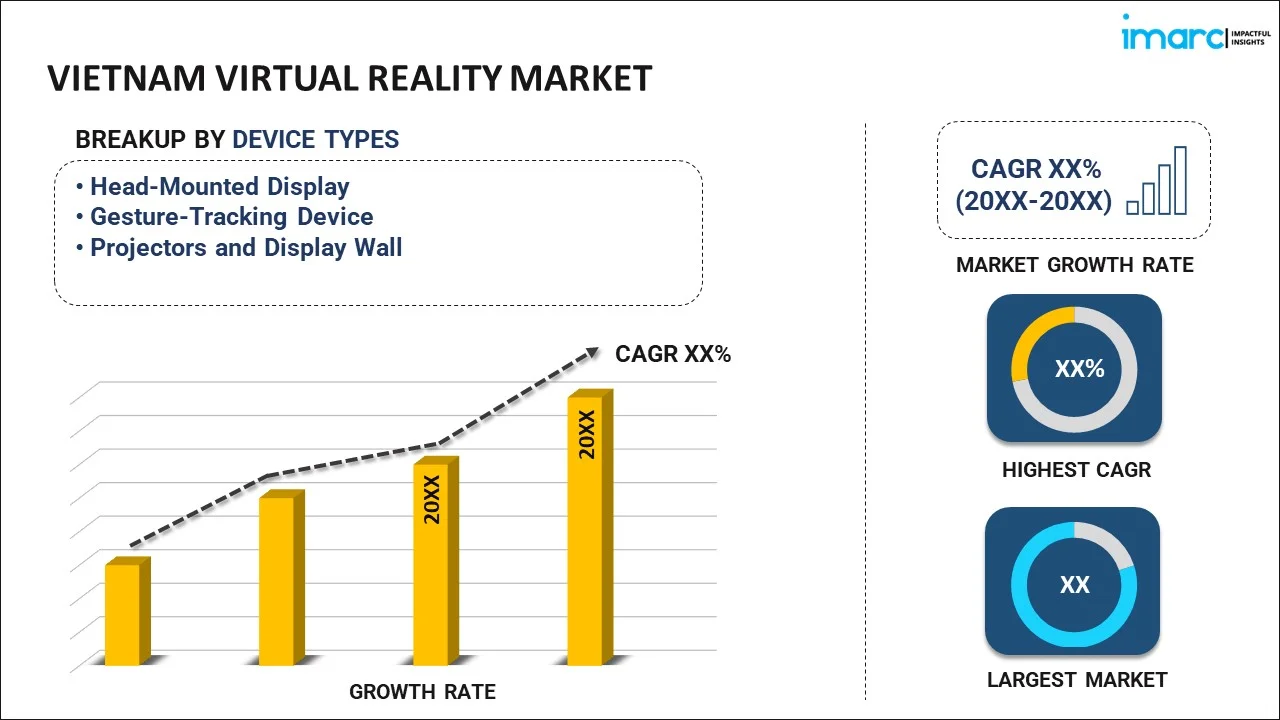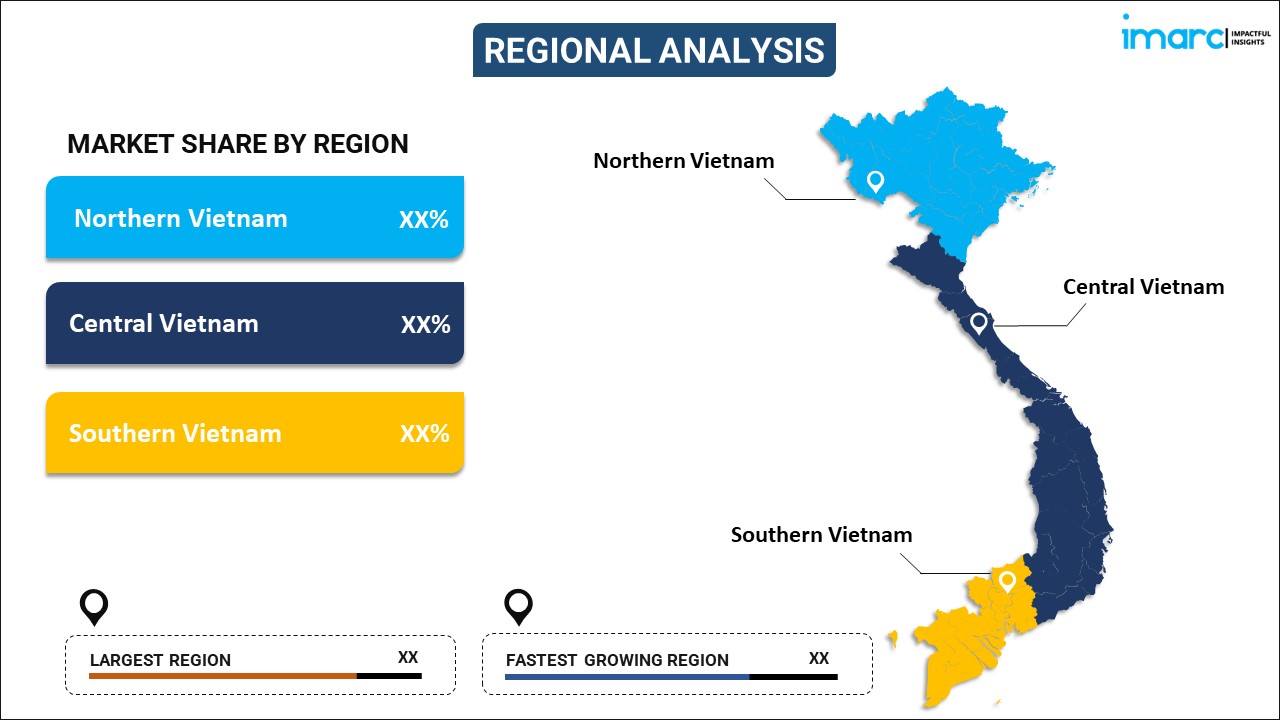
Vietnam Virtual Reality Market Report by Device Type (Head-Mounted Display, Gesture-Tracking Device, Projectors and Display Wall), Component (Hardware, Software), Technology (Semi and Fully Immersive, Non-Immersive), Application (Aerospace and Defense, Consumer, Commercial, Enterprise, Healthcare, and Others), and Region 2026-2034
Market Overview:
Vietnam virtual reality market size reached USD 95.9 Million in 2025. Looking forward, IMARC Group expects the market to reach USD 513.6 Million by 2034, exhibiting a growth rate (CAGR) of 20.50% during 2026-2034. The increasing demand for 5G networks that offer lower latency and higher bandwidth, which is essential for delivering high-quality virtual reality (VR) experiences, especially for streaming VR content and real-time multiplayer gaming, is driving the market.
|
Report Attribute
|
Key Statistics
|
|---|---|
|
Base Year
|
2025
|
|
Forecast Years
|
2026-2034
|
|
Historical Years
|
2020-2025
|
| Market Size in 2025 | USD 95.9 Million |
| Market Forecast in 2034 | USD 513.6 Million |
| Market Growth Rate 2026-2034 | 20.50% |
Access the full market insights report Request Sample
Virtual reality is a computer-generated, immersive technology that enables users to interact with and experience a simulated environment as if they were physically present within it. It typically involves wearing a headset equipped with displays and sensors to track head and sometimes body movements. These headsets create a 3D, 360-degree environment that responds to the user's actions and inputs, providing a convincing illusion of being in a different world. VR has a wide range of applications, from entertainment and gaming to education, healthcare, and training simulations. It can transport users to fantastical realms, enable virtual travel, facilitate medical therapy, and enhance training experiences by simulating real-world scenarios. By immersing users in these digital environments, VR has the potential to revolutionize industries and change how people learn, play, and work. As technology continues to advance, VR's capabilities and accessibility are expected to grow, offering even more transformative experiences.
Vietnam Virtual Reality Market Trends:
The virtual reality market in Vietnam has witnessed remarkable growth in recent years, driven by several key market drivers. To begin with, technological advancements have played a pivotal role in shaping the VR landscape. As computing power continues to increase and hardware becomes more affordable, VR experiences have become more accessible to consumers. Moreover, the ongoing development of high-resolution displays and sophisticated tracking systems has enhanced the overall immersion and realism of VR content. Additionally, the expanding gaming and entertainment industry has been a significant driving force behind VR's growth. This has not only expanded the consumer base but also spurred innovation in hardware and software development. Furthermore, the inflating application of VR in industries such as healthcare, education, and training to simulate real-world scenarios and provide hands-on training in a safe, controlled environment is expected to drive the virtual reality market in Vietnam during the forecast period.
Vietnam Virtual Reality Market Segmentation:
IMARC Group provides an analysis of the key trends in each segment of the market, along with forecasts at the country level for 2026-2034. Our report has categorized the market based on device type, component, technology, and application.
Device Type Insights:

To get detailed segment analysis of this market Request Sample
- Head-Mounted Display
- Gesture-Tracking Device
- Projectors and Display Wall
The report has provided a detailed breakup and analysis of the market based on the device type. This includes head-mounted display, gesture-tracking device, and projectors and display wall.
Component Insights:
- Hardware
- Software
A detailed breakup and analysis of the market based on the component have also been provided in the report. This includes hardware and software.
Technology Insights:
- Semi and Fully Immersive
- Non-Immersive
The report has provided a detailed breakup and analysis of the market based on the technology. This includes semi and fully immersive and non-immersive.
Application Insights:
- Aerospace and Defense
- Consumer
- Commercial
- Enterprise
- Healthcare
- Others
A detailed breakup and analysis of the market based on the application have also been provided in the report. This includes aerospace and defense, consumer, commercial, enterprise, healthcare, and others.
Regional Insights:

To get detailed regional analysis of this market Request Sample
- Northern Vietnam
- Central Vietnam
- Southern Vietnam
The report has also provided a comprehensive analysis of all the major regional markets, which include Northern Vietnam, Central Vietnam, and Southern Vietnam.
Competitive Landscape:
The market research report has also provided a comprehensive analysis of the competitive landscape. Competitive analysis such as market structure, key player positioning, top winning strategies, competitive dashboard, and company evaluation quadrant has been covered in the report. Also, detailed profiles of all major companies have been provided.
Vietnam Virtual Reality Market Report Coverage:
| Report Features | Details |
|---|---|
| Base Year of the Analysis | 2025 |
| Historical Period | 2020-2025 |
| Forecast Period | 2026-2034 |
| Units | Million USD |
| Scope of the Report | Exploration of Historical Trends and Market Outlook, Industry Catalysts and Challenges, Segment-Wise Historical and Future Market Assessment:
|
| Device Types Covered | Head-Mounted Display, Gesture-Tracking Device, Projectors and Display Wall |
| Components Covered | Hardware, Software |
| Technologies Covered | Semi and Fully Immersive, Non-Immersive |
| Applications Covered | Aerospace and Defense, Consumer, Commercial, Enterprise, Healthcare, Others |
| Regions Covered | Northern Vietnam, Central Vietnam, Southern Vietnam |
| Customization Scope | 10% Free Customization |
| Post-Sale Analyst Support | 10-12 Weeks |
| Delivery Format | PDF and Excel through Email (We can also provide the editable version of the report in PPT/Word format on special request) |
Key Questions Answered in This Report:
- How has the Vietnam virtual reality market performed so far and how will it perform in the coming years?
- What has been the impact of COVID-19 on the Vietnam virtual reality market?
- What is the breakup of the Vietnam virtual reality market on the basis of device type?
- What is the breakup of the Vietnam virtual reality market on the basis of component?
- What is the breakup of the Vietnam virtual reality market on the basis of technology?
- What is the breakup of the Vietnam virtual reality market on the basis of application?
- What are the various stages in the value chain of the Vietnam virtual reality market?
- What are the key driving factors and challenges in the Vietnam virtual reality?
- What is the structure of the Vietnam virtual reality market and who are the key players?
- What is the degree of competition in the Vietnam virtual reality market?
Key Benefits for Stakeholders:
- IMARC’s industry report offers a comprehensive quantitative analysis of various market segments, historical and current market trends, market forecasts, and dynamics of the Vietnam virtual reality market from 2020-2034.
- The research report provides the latest information on the market drivers, challenges, and opportunities in the Vietnam virtual reality market.
- Porter's five forces analysis assist stakeholders in assessing the impact of new entrants, competitive rivalry, supplier power, buyer power, and the threat of substitution. It helps stakeholders to analyze the level of competition within the Vietnam virtual reality industry and its attractiveness.
- Competitive landscape allows stakeholders to understand their competitive environment and provides an insight into the current positions of key players in the market.
Need more help?
- Speak to our experienced analysts for insights on the current market scenarios.
- Include additional segments and countries to customize the report as per your requirement.
- Gain an unparalleled competitive advantage in your domain by understanding how to utilize the report and positively impacting your operations and revenue.
- For further assistance, please connect with our analysts.
 Request Customization
Request Customization
 Speak to an Analyst
Speak to an Analyst
 Request Brochure
Request Brochure
 Inquire Before Buying
Inquire Before Buying




.webp)




.webp)












